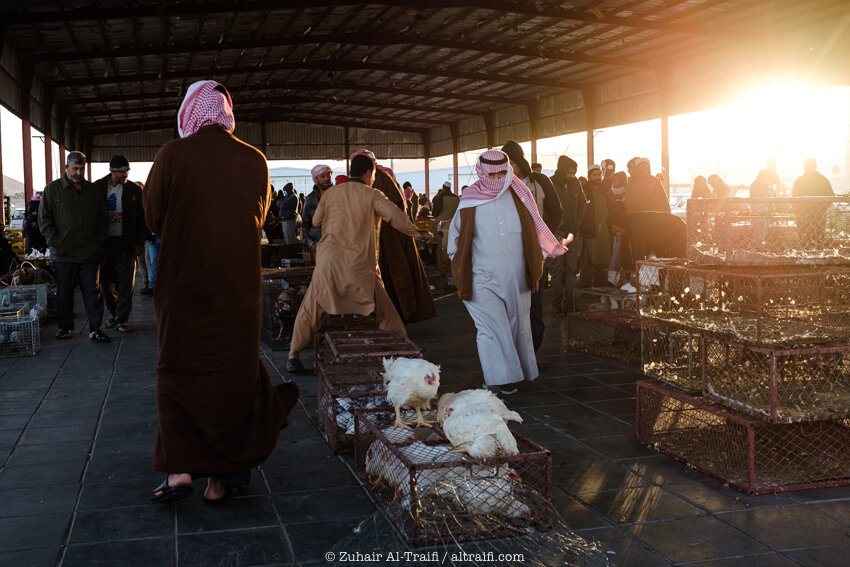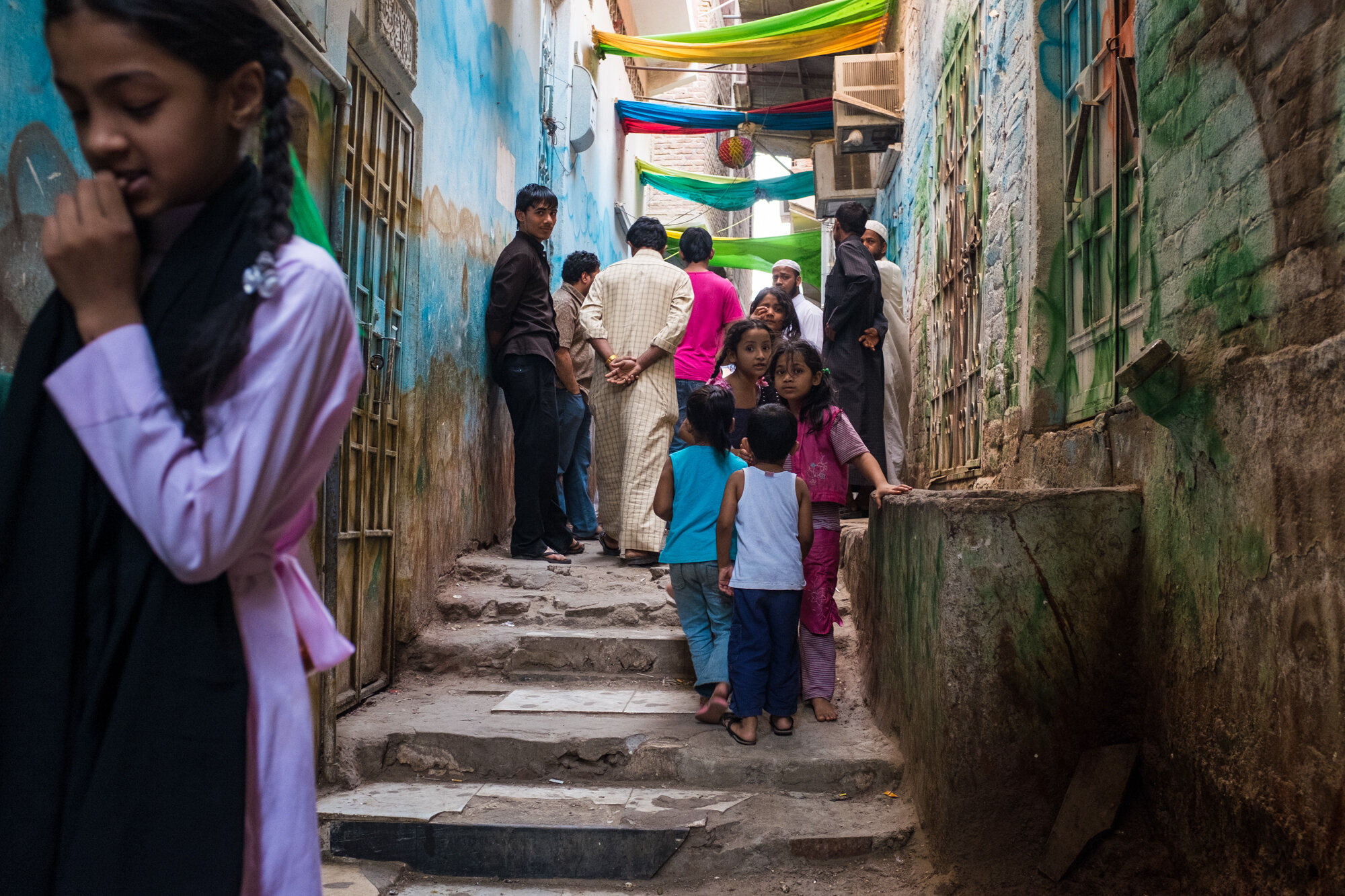Zuhair Al-Traifi: Alleyways and Tear Downs
Zuhair Al-Traifi is 33 years old and comes from the city of Dammam in eastern Saudi Arabia. Zuhair works as an electrician for the Saudi Electricity Company, but during his free time, he is passionate about documenting street life in Saudi Arabia.
His work is raw and real, as he looks to show the lesser-seen aspects of normal, working daily life in the Kingdom. He prefers to photograph old residential areas, alleyways, village streets and markets. Zuhair believes these places offer a more regular and realistic depiction of daily life-- old men sitting together chatting, women wearing black abaya walking in alleys, marketeers simply selling their wares, and children playing full of life and joy.
This type of photography is not appreciated as much as it should be in the Kingdom. Zuhair does not shy away from presenting the grittier parts of Saudi cities, showing graffiti, collapsed buildings, tear downs, crowded markets, and images that are far less presentable than certain people would prefer. This makes his photography particularly well-positioned to helping viewers learn about average working life in Saudi Arabia.
Dammam, Saudi Arabia. An outdoor chicken market in Dammam. Zuhair Al-Traifi.
Where did you grow up and how have the changes you’ve experienced in Saudi Arabia transformed or challenged your photography?
I’ve lived in Dammam for my whole life, born and raised. Dammam is not an old city, not more than 80 years old or so, but my parents are originally from Al Hasa District which is about 150km away from Dammam.
Al Hasa has a lot of small villages and my parents grew up in one of them. We visit our ancestral village from time to time and after I became more interested in street photography, I visited a lot more of the neighbouring villages in order to photograph the daily lives of the people there.
Dammam itself doesn't have many interesting places to photograph, and there is only one area in the city which is kind of historic. I would go here a lot in my first years as a photographer, but as my passion grew, I started to travel outside of the city a lot more— at least twice a month and sometimes more in order to explore new areas and markets to photograph them.
Al Hasa, Saudi Arabia. Three men sit outside a local mosque. Zuhair Al-Traifi.
Ha’il, Saudi Arabia. Three men eat and drink tea at the Friday Market in Ha’il City. Zuhair Al-Traifi.
Ha’il, Saudi Arabia. Two chickens fight as onlookers gather at Ha’il’s Friday Market. Zuhair Al-Traifi.
Ha’il, Saudi Arabia. Early morning scenes from the Friday Market. Zuhair Al-Traifi.
How did you first get into photography and where does your inspiration come from?
How I got into photography is a bit of a weird story. When I was a kid I always wanted to buy an old film camera to photograph my family and our vacations, but because my father couldn't afford to buy me a really good camera I stopped thinking about it.
I completely forgot about photography until 2006, when I bought a small point and shoot camera. Like any other Saudi teenager, I loved cars so I would go to places where people would show off their cool cars. There, I would photograph them. This continued until about 2010 when I bought my first DSLR camera. Even though it was a 4-year-old Canon 400D, I still really loved it. That year, I took a five-day course for basic photography skills, which really set me off on a good start.
In 2012 after meeting with a lot of photographer friends, I found myself drawn to documenting street life and portraits. After a year, I noticed something important— local photographers were not giving much attention to street photography. After observing this, I decided to start a project with a simple goal: shooting daily life and street scenes in my country. This really kept me motivated to shoot more and more, and because of this I started to Google a lot of street photographers from around the world and noticed how famous and old this category of photography really is.
This is also the time when I learned about some of the great photographers like Henri Cartier, Robert Cappa, and Edward Curtis. I'm a really big fan of these photographers the treasures they’ve left behind.
I'm basically targeting old residential areas and markets. These places are on the verge of extinction in Saudi Arabia— the old buildings, the traditional clothing, the people's habits and traditions. For example, in 2013 I rarely saw a seller busy on his smartphone, but nowadays it's rare to see the opposite!
Anyhow, it's funny how I see myself documenting these scenes at this critical point of time and truly wish that I were able to do this twenty years earlier but better late than never.
Al Hasa, Saudi Arabia. Two men sit on the street sipping tea. Zuhair Ahmad Al-Traifi.
Al Hasa, Saudi Arabia. Young girls poke out from their home to take a look. Zuhair Ahmad Al-Traifi.
As a street photographer, your work transports the viewer to a place that feels very local. What stories are you looking to tell through your images and what do they say about daily life for working people in Saudi Arabia?
When I'm out for photography I usually target a couple of types of places. The first types are old residential neighbourhoods. These places reflect the average lives of normal people— small streets, alleys, random houses— which provide great insights into the lives of working people. You can see old men sitting together chatting, women wearing abaya walking down the alleys, and of course, children playing, bringing life and joy to the streets.
The other places I typically like to go to are old souqs of Saudi cities where you can find a lot of things being sold in a very simple way. You can see vendors just sitting on the floor with a piece of cloth in front of them of selling vegetables and herbs. Also, in these kinds of markets, you can see the poor and the rich alike come here to find what they need. This is really amazing because it reflects how people see the importance of these kinds of markets.
Dammam, Saudi Arabia. An old man sits in front of his residence. Zuhair Al-Traifi.
Dammam, Saudi Arabia. An old woman in an abaya walks in a residential neighbourhood. Zuhair Al-Traifi.
Abha, Saudi Arabia. A honey merchant displays his goods in front of his shop. Zuhair Al-Traifi.
Abha, Saudi Arabia. Honey is a major product of this region, locals bid on prices. Zuhair Al-Traifi.
What have been some of the most emotionally moving places and subjects you’ve photographed in Saudi Arabia?
One of them was in the holy city of Makkah, where there were several residential areas that are considered to be informal (not fully legal) and the residents of these neighbourhoods are mostly foreign labourers.
When I was photographing this area, a lot of people were asking me: “Are you photographing for the demolitions?” They were told the government had plans to demolish the whole area because they believed it had a lot of crime, like drugs, kidnapping, and stealing.
Still, as far as I could see the people living there were very peaceful, so deep inside of me, I was moved to document this place before it would be lost forever. This was back in 2014 and they have since demolished the neighbourhood along with others around Makkah for good. I don't know exactly what happened to the residents but I’ve heard the government gave them houses and apartment buildings, but honestly, I’m not sure about that.
Makkah, Saudi Arabia. Residents gather young and old in an alleyway of Makkah city. Zuhair Al-Traifi.
Makkah, Saudi Arabia. An old neighbourhood in Makkah before it was demolished. Zuhair Al-Traifi.
Makkah, Saudi Arabia. A man rests on a couch outside an old neighbourhood of Makkah. Zuhair Al-Traifi.
What is your favourite photograph you’ve take in Saudi Arabia? What about capturing this moment do you remember?
Well, this is a tough one; I can think of a lot of favourites. If you ask me to choose one, I guess I'll go with a photo I took in Unaizah city, located in the middle of Saudi Arabia.
It is a photo of a boy standing beside his younger sister, expect the sister was facing the other way around. I wanted to take a photo of them, and asked for the boy's name and told me, but when I asked the little girl for her name she became very shy and refused to tell me. When I started photographing them both again, rather than run away from my camera, she decided to face the other way, as to not show her face.
Unaizah, Saudi Arabia. A brother stands for the camera, while his little sister turns her back to the camera. Zuhair Al-Traifi.
What are some places in Saudi Arabia you are looking to explore? What about these places makes you want to visit?
So far I’ve visited about 30 cities or so in Saudi Arabia, but what I really want to do is stay with the bedouins in the desert. This is really hard to do because you need a friend who knows a tribe personally in order for you to photograph them.
Another place I’d like to visit is the Jazan Region in the south of Saudi Arabia because it has many mountains and small villages, which makes it a perfect place for photography and documenting life. Also, the mountains there are green and covered with trees, which is very different from the usual desert scenes we see in much of Saudi Arabia. This region’s culture is also entirely different from the rest of Saudi Arabia.
I’ve only visited there once before and I hope I get another chance to do so in the near future.
Al Hasa, Saudi Arabia. Two women walk through an alleyway just before sunset. Zuhair Al-Traifi.
Abha, Saudi Arabia. A woman sells sugar cane at a street market in Abha. Zuhair Al-Traifi.
Qatif, Saudi Arabia. A man a Al-Khamis market shows photos of his deceased relatives and friends that he keeps in his wallet to remember them. Zuhair Al-Traifi.
Qatif, Saudi Arabia. A portrait of the man from the previous image. Zuhair Al-Traifi.
After visiting Saudi Arabia myself this year, I believe in showing people a different side to the country— a human side— that is not so often seen in Western media. How do you think your photographs can play a role in shifting perspectives of the Kingdom?
To be honest, most of my images are disliked by the tourism ministry. In their mind, they want to present photos that only show positive, beautiful, vibrant and clean places, but a lot of my photos don't fall into these categories. I just want to show what's truly happening in the daily lives of people in Saudi Arabia.
A lot of foreigners think of Saudi as a rich country, and a rich country means rich people, yes?
Of course, that's wrong, but I think that's how a lot of people are thinking. This is why I go to neighbourhoods and markets not usually shown in the media in order to capture photos that show the realities of life. I want to document these things and let the world know this is what Saudi Arabia really looks like for most local people.
I'm far away from capturing what may attract people to the country, but that's a job for a lot of other photographers and I have faith that they can do it. I’d prefer to do what I’m already doing, and it’s something that nobody else is really focusing on (in the last few years some have started to photograph the streets of Saudi as well, but only a small number of them are still going).




















